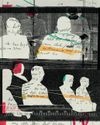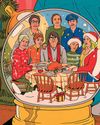
The Whitehouse Farm murders were an unusual case, because from the outset there were only two plausible killers.
Whitehouse Farm stood in open fields, facing the bleak Essex salt marshes, its columned portico lit by the moon. It was a midsummer night, nearing 4 A.M., when a patrol car sped toward the property. Three police officers got out at the end of the driveway, and a silver car pulled up behind. The driver, Jeremy Bamber, was the twenty-four-year-old scion of a local farming dynasty; his parents, Nevill and June, occupied the Whitehouse. Bamber had phoned the police half an hour earlier to report a panicked call from his father. His sister, Sheila, had “gone berserk,” he said. Her six-year-old twin sons were asleep upstairs, and she had a gun.
Two of the officers told Bamber to follow them. The Whitehouse lay around a bend, concealed by tall trees, and they crept through the darkness until its rear wall came into view. Lights were shining in three windows: the kitchen, a bathroom, and the bedroom where Sheila’s twins were sleeping. But the only sound from within was the faint whining of a dog. They cut across a field to the front, where light filtered through the curtains of the master bedroom. Seeing a shadow looming at the window, the men ducked behind a hedge and braced for shots. When none came, they raced back toward the patrol car, the officers radioing for reinforcements.
At the car, Bamber made a confession. The previous night, before heading home from work on the farm, he had taken his father’s .22 Anschutz rifle out to shoot rabbits—and he had left the weapon in the kitchen, its magazine still loaded. “Oh, God,” he said. “I hope she hasn’t done anything silly.”
This story is from the August 05, 2024 edition of The New Yorker.
Start your 7-day Magzter GOLD free trial to access thousands of curated premium stories, and 9,000+ magazines and newspapers.
Already a subscriber ? Sign In
This story is from the August 05, 2024 edition of The New Yorker.
Start your 7-day Magzter GOLD free trial to access thousands of curated premium stories, and 9,000+ magazines and newspapers.
Already a subscriber? Sign In

GET IT TOGETHER
In the beginning was the mob, and the mob was bad. In Gibbon’s 1776 “Decline and Fall of the Roman Empire,” the Roman mob makes regular appearances, usually at the instigation of a demagogue, loudly demanding to be placated with free food and entertainment (“bread and circuses”), and, though they don’t get to rule, they sometimes get to choose who will.

GAINING CONTROL
The frenemies who fought to bring contraception to this country.

REBELS WITH A CAUSE
In the new FX/Hulu series “Say Nothing,” life as an armed revolutionary during the Troubles has—at least at first—an air of glamour.

AGAINST THE CURRENT
\"Give Me Carmelita Tropicana!,\" at Soho Rep, and \"Gatz,\" at the Public.

METAMORPHOSIS
The director Marielle Heller explores the feral side of child rearing.

THE BIG SPIN
A district attorney's office investigates how its prosecutors picked death-penalty juries.

THIS ELECTION JUST PROVES WHAT I ALREADY BELIEVED
I hate to say I told you so, but here we are. Kamala Harris’s loss will go down in history as a catastrophe that could have easily been avoided if more people had thought whatever I happen to think.

HOLD YOUR TONGUE
Can the world's most populous country protect its languages?

A LONG WAY HOME
Ordinarily, I hate staying at someone's house, but when Hugh and I visited his friend Mary in Maine we had no other choice.

YULE RULES
“Christmas Eve in Miller’s Point.”